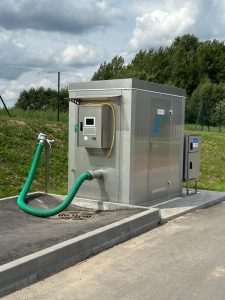How receiving imported wastewater can raise the country’s EPI rating
- What is ETI and how is it calculated ?
What is EPI?
What is imported wastewater ?
How is incoming wastewater treated ?
Why is the reception of incoming wastewater important ?
How can the latest technologies in the field of wastewater reception contribute to better environmental performance?
Automated systems.
Remote monitoring and control systems.
Innovative measurement and analysis tools.
Data management and analysis software.
Integrated systems and their advantages.
Benefits of automated systems.
Advantages of data acquisition and analysis.
Successful implementation examples.
Future perspectives
Conclusions
Efficient wastewater management is an important indicator for a country’s Environmental Performance Index (EPI). In Lithuania, increasing attention is being paid to modernising the reception of incoming wastewater to ensure higher water quality and reduce environmental pollution. This article discusses the latest technologies and innovations in this field and how they can contribute to better EPI results.
What is EPI and how is it calculated ?
The Environmental Performance Index (EPI) is a method developed by Yale University and Columbia University that provides the most comprehensive assessment of the state of sustainability around the world, using the latest data sets, science and technology. These indicators show how close countries are to their environmental policy targets in eleven categories.
One of these eleven categories is water resources, which measures the extent to which people are reducing the threat to aquatic ecosystems from wastewater generation and improper management. To more accurately assess and review wastewater management gaps and policy priorities, the EPI 2024 has expanded the assessment indicators in this category. In previous years, performance was calculated in terms of the proportion of wastewater subject to at least primary treatment and the proportion of the population connected to a wastewater collection system. For the first time in 2024, this indicator for wastewater treatment has been decomposed into collection and primary treatment, and two new indicators have been added: the amount of wastewater generated per inhabitant per year and wastewater reuse.
Comparison between Finland and Lithuania.
Following a change in the calculation methodology and aggregation of the indicators, Finland, which was first in the wastewater treatment category in 2022, dropped to 20th in 2024, while Lithuania moved up from 40th to 35th place. However, in terms of the percentage of wastewater collected for treatment, Finland is still one of the leading countries, while Lithuania is in 45th place.
Why is this difference, even though both Lithuania and Finland have a significant number of people who are not connected to a centralised sewerage network? Finland has a tradition of water management dating back to the 1960s, and the population, which manages its own wastewater, all has some form of wastewater storage or treatment facility. Finnish water management laws require that even holiday homes, which are only occupied for a few weeks of the year, have tanks for collecting wastewater. In Lithuania, however, there are still many households without any wastewater storage or treatment facilities that cannot collect wastewater. This is why the percentage of wastewater collection in Finland is so high
What is wastewater from wastewater collection ?
In Lithuania, as in many other countries, people in remote, sparsely populated areas are not connected to centralised sewerage networks. While this would be ideal, in such places the installation and maintenance of a centralised sewage system is extremely expensive.
Therefore, in many villages, hamlets, holiday homes or remote industrial establishments, private sewage treatment plants, septic tanks and storage tanks are already in use, or should be installed, as an alternative to sewerage networks. There will be a long-standing need for wastewater from such plants to be collected by specialised sewage collection vehicles and transported to district or city sewage treatment plants for further treatment. Such wastewater, which is collected by special vehicles and transported to wastewater treatment plants, is called ‘imported wastewater’.

